SISCO handheld barometer altimeter compass with thermometer is designed for hikers and adventurers who seek accurate and convenient environmental information across a wide range of conditions. It is tough and built to withstand severe environments, providing reliable protection for all users in diverse outdoor settings.
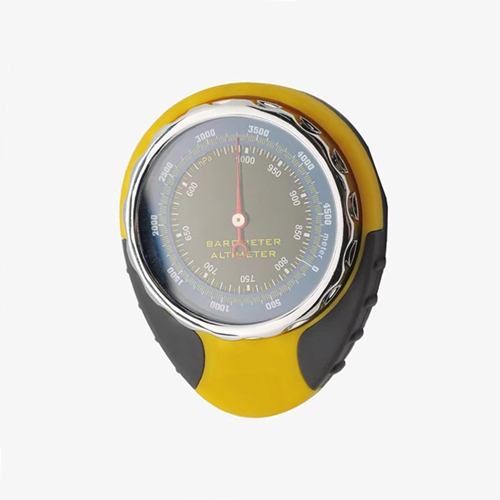
Multifunctional Baro Altimeter
- Metal texture and rubber feel.
- High-quality ABS material, corrosion-resistant and can be used under harsh conditions. Resistant to atmospheric corrosion.
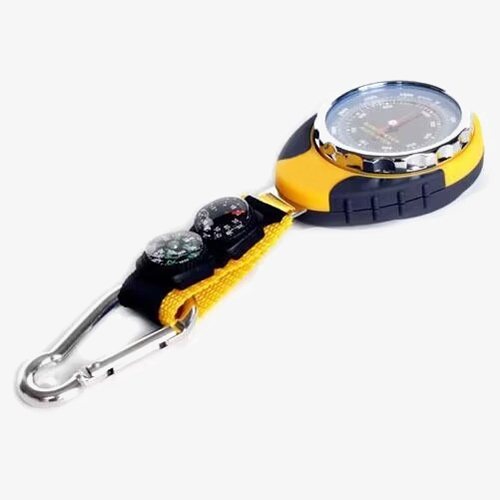
Parameter Settings
- Convenient hook, easy to carry.
- Four-in-one function, can measure direction, height, temperature, air pressure.
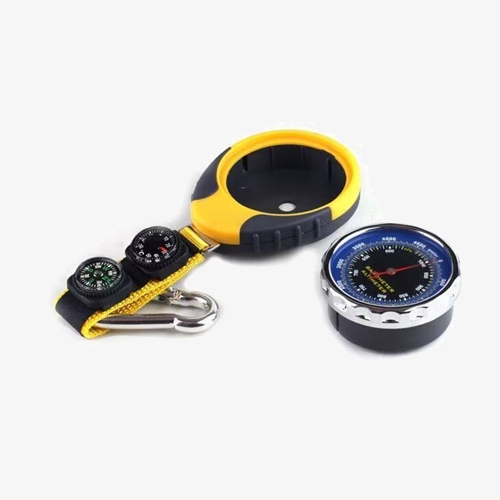
Innovative and Removable Design
- The back of the portable altimeter is anti-slip paint, taking into account both aesthetics and anti-slip.
- The step to remove dial: Adjust the initial value ofheight, Hold the base with one hand, Twist the silver case other hand, Turn slowly.
- Fashionable and sporty appearance: Ergonomically designed to adapt to a variety of complex environments.
Applications
A portable barometer altimeter compass with thermometer is an essential tool for various outdoor activities, providing critical information on altitude and atmospheric pressure. Hikers and climbers use it to monitor their ascent and ensure they are on the correct path, while mountaineers rely on it for precise altitude readings in high-altitude environments. In addition, outdoor enthusiasts such as skiers and snowboarders benefit from its ability to track elevation changes and predict weather shifts based on pressure trends.

Climbing

Camping

Riding

Hiking
| Model | SISCO-ALM-FR381 |
| Measuring Height | 0-5000m |
| Measuring Air Pressure | 580-1040 Pa |
| Measure Temperature | -30℃~50℃ |
| Measurement Resolution | 20 meters |
| Storage Conditions | Temperature between -30°C ~ 65°C, humidity less than 90% |
| Carrying Method | Hanging buckle |
| Material | Plastic, aluminum, carbon steel, stainless steel, copper, rope |
| Size | 68mm (diameter) * 85mm (length) * 67mm (compass length) |
| Weight | 90g |
Details
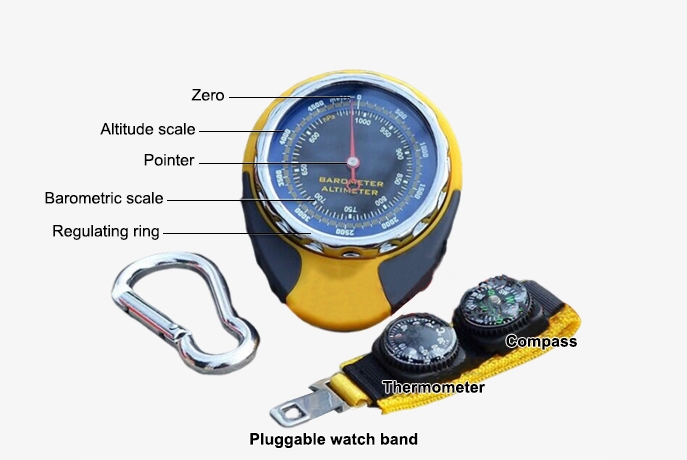
Packing List
- 1 x Altimeter
- 1 x Compass
- 1 x Thermometer
- 1 x String
- 1 x User manual
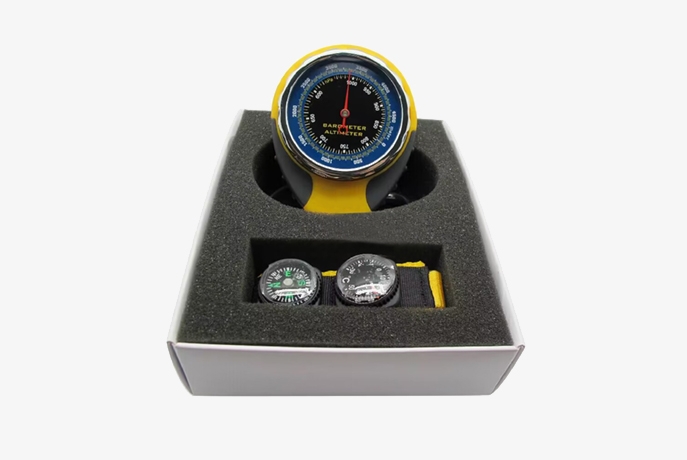
Q1: What does the altimeter 29.92 mean?
A1: The altimeter reading of 29.92 refers to the barometric pressure setting in inches of mercury (inHg) that is used to calibrate an altimeter. Specifically, 29.92 inHg is the standard sea-level pressure in the International Standard Atmosphere (ISA). When an altimeter is set to 29.92 inHg, it indicates that the instrument is using this standard pressure to calculate altitude. This setting is commonly referred to as the "standard pressure setting" and is used by pilots when flying at altitudes known as flight levels (e.g., FL180, which is 18,000 feet above sea level in the standard atmosphere).
Q2: How often should I change the altimeter setting in aviation?
A2: In aviation, it is necessary to adjust the altimeter setting frequently to ensure accurate altitude readings. Typically, pilots set the altimeter to local barometric pressure (QNH) when descending below the transition altitude, and to standard pressure (QNE) above it. Additionally, the altimeter setting should be adjusted approximately every 1000 feet of ascent or descent to accommodate changes in atmospheric pressure, ensuring precise altitude awareness for flight safety.
Q3: Does weather affect the outdoor digital baro altimeter?
A3: Weather can significantly impact the accuracy of a digital barometric altimeter by causing fluctuations in atmospheric pressure. As weather systems like high and low-pressure areas move through an area, they can cause rapid changes in atmospheric pressure, which directly affects the altimeter's ability to accurately measure altitude. Temperature changes also play a role, as they influence air density and subsequently atmospheric pressure. While digital barometric altimeters are equipped with features like temperature compensation to mitigate these effects, extreme weather conditions such as severe storms or rapid temperature shifts may still necessitate recalibration to maintain precise altitude readings. Users must monitor weather conditions closely and potentially recalibrate their altimeters as needed to ensure reliable performance.
Tips: What are the arrows on the digital altimeter barometer?
The arrows on an altimeter typically indicate the trend in altitude change. Here's how they generally work:
- Single Arrow (Up or Down): This arrow indicates whether your altitude is increasing (up arrow) or decreasing (down arrow) at a rate of at least 100 feet per minute (fpm). It's a quick visual indicator of your current rate of climb or descent.
- Double Arrow (Up or Down): If you see two arrows pointing up or down, it means your rate of climb or descent is greater than 1000 fpm. This serves as a warning that you are ascending or descending rapidly.
These arrows help pilots and users of altimeters quickly assess their vertical speed without needing to read the exact altitude change in feet per minute. It's a valuable visual aid for maintaining stable flight or ascent/descent rates.
Thank you for buying industrial test and measurement equipment on SISCO.com, all products sold by SISCO and the partner cover a 12 months warranty, effective from the date of receiving the products.
What is covered?
SISCO is responsible for providing free spare parts, and free technical support to assist the customer to repair the defective products until the problem is solved.
What is not covered?
- Product purchased from anyone other than a SISCO store or a SISCO authorized reseller.
- Expendable parts.
- Routine cleaning or normal cosmetic and mechanical wear.
- Damage from misuse, abuse or neglect.
- Damage from use of parts other than SISCO approved.
- Damage from use outside the product’s usage or storage parameters.
- Damage from use of parts not sold by SISCO.
- Damage from modification or incorporation into other products.
- Damage from repair or replacement of warranted parts by a service provider other than a SISCO authorized service provider.
- Damage caused by the application environment not meeting the product usage requirements and the failure to perform preventive maintenance.
1.Fast delivery, Well packed.
2. It’s entirely mechanical, requiring no batteries, and is very accurate. Lightweight and easy to read, it fits comfortably in the palm of your hand. I’ve used it several times on mountain hikes, and it reliably keeps me at the correct elevation.

